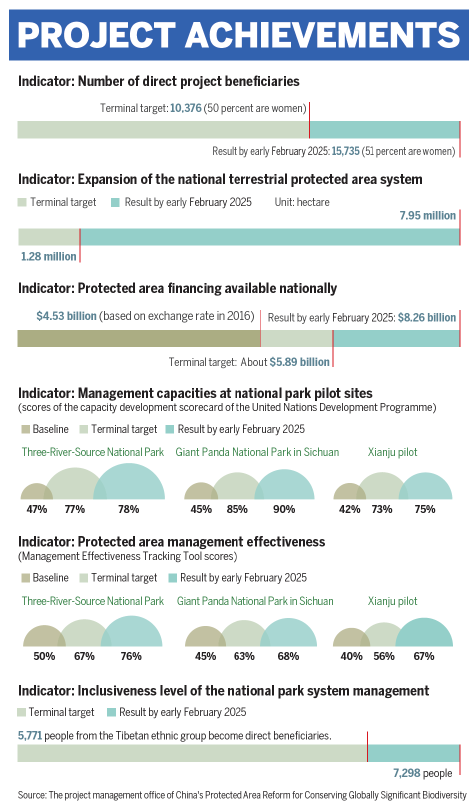
The Three-River-Source National Park in Qinghai province. LI YOUCHONG/FOR CHINA DAILY
China's Protected Area Reform for Conserving Globally Significant Biodiversity (C-PAR1), financed by the Global Environment Facility, has achieved remarkable success, surpassing several objectives by a significant margin.
The project, which started in 2019, achieved a "satisfactory" midterm review in March 2022. By January 2025, it concluded a "satisfactory" terminal review. The project is to end in March.
Jointly implemented by the Foreign Environmental Cooperation Center of the Ministry of Ecology and Environment (FECO/MEE), and the United Nations Development Programme (UNDP), C-PAR1 has played a pivotal role in effectively tackling key obstacles impeding China's overarching objectives of biodiversity conservation while also cultivating valuable insights for global reference on harmonizing protection and development within local communities.
C-PAR1 identified three critical challenges that need to be addressed in order to propel the country toward achieving its long-term biodiversity conservation goals: a deficient legislative framework and ineffective governmental oversight of protected areas, a scarcity of expertise and experiences for provincial-level national park administrations, and inadequate mechanisms for information exchange and coordination.
Thanks to the collaborative efforts of C-PAR1's eight project steering committee member units — the FECO/MEE, the National Forestry and Grassland Administration (NFGA), the Ministry of Finance, the MEE, the UNDP, the Three-River-Source National Park Administration, the Sichuan Administration of Giant Panda National Park, the People's Government of Xianju County, Zhejiang Province — and numerous partners and experts, all the three challenges have been essentially resolved, with the achievement directly serving national government bodies' decision-making and the country's legislation process.

A scene at the Giant Panda National Park, which straddles the provinces of Sichuan, Shaanxi and Gansu. MA WENHU/FOR CHINA DAILY
Propelling decisions
The accomplishments of C-PAR1, for instance, have directly influenced policymaking within the MEE, facilitating the alignment of decisions along with the goals of the Convention on Biological Diversity, or CBD.
Additionally, its impact extends to guiding the NFGA in formulating strategies for the construction and effective management of national parks.
In overseeing protected areas, the project has played a pivotal role in setting up a robust evaluation platform to assess the effectiveness in ecological and environmental protection. The platform, which went online in September 2023, now covers 322 national protected areas in 25 provincial-level regions.
C-PAR1 has extended its support to a crucial technical platform that leverages satellite technology for monitoring protected areas. Its scope encompasses various studies such as monitoring protected areas in relation to optimizing and integrating protected areas, supervising ecological conservation red lines, and overseeing marine protected areas. These efforts have furnished the MEE with essential technical assistance.
C-PAR1's study results concerning biodiversity funds have facilitated the implementation of certain CBD goals. Two capacity buildups have enabled 139 young staff members across the country to improve their competency in the supervision of protected areas.
The study findings in the realm of protected area management cater to the pressing requirements of the NFGA. These findings encompass the development of national-level guidelines for planning and monitoring protected areas in the face of climate change, guidelines for national park concessions, policies for addressing human-wildlife conflicts, guidelines for the cross-provincial management of national parks and the management of their natural assets, as well as the establishment of sustainable financing mechanisms. These mechanisms include diverse financing and investment strategies, valuing ecological products, utilizing green funds, and encouraging social donations.
Specifically, four key findings related to human-wildlife conflict policies and guidelines, as well as national park concessions, have been promptly communicated to the NFGA.

Contributing to legislation
C-PAR1 stands out as a project of great significance also because of its contribution to China's legislation on biodiversity conservation, providing a rare example where research could promote national legislation. It has contributed to China's national park legislation in both top-down and bottom-up approaches.
At the national level, the project has contributed to the top-down national park legislation process. With the in-depth participation of Chief Technical Adviser Wang Yi, a member of the Standing Committee of the National People's Congress, the project's legislative specialist, Lyu Zhongmei, vice-chairman of Environmental Protection and Resources Conservation Committee of National People's Congress, key stakeholders from the MEE, the NFGA, the UNDP and famous law schools, the results of the project study have contributed 43 pages of comments for the NFGA to draft national park legislation since 2020. A draft law is now being deliberated by the 14th NPC Standing Committee.
At the provincial level, project specialists and key stakeholders engaged in the national park legislation process have collaborated to enact or revise eight national park legislation documents across three pilot sites. These efforts have significantly contributed to the development of an innovative bottom-up legislation system. Leveraging the resources of the Global Environment Facility, or GEF, and expert inputs from its projects, C-PAR1 has actively promoted and publicized the drafting and implementation of the national park law and associated regulations through diverse platforms and channels.
International significance
C-PAR1 assimilated advanced international ideas and experiences into its pilot sites, and that has enabled those sites to cultivate distinct "Chinese practices" that can be showcased both domestically and internationally. In the Three-River-Source National Park, the efforts of C-PAR1 to promote the local community to participate in the park's management by providing training opportunities have not only enriched the knowledge of trainees, but also increased their skills and incomes, benefiting 8,503 people.
The pilot park chose 28 out of 1,950 households to showcase 10 physical precaution and protection measures aimed at safeguarding themselves from wildlife encounters, while also delving into the management of human-wildlife conflicts.
In the Giant Panda National Park, C-PAR1's pilot project to involve the local community in managing the park benefited 2,960 villagers via nature education and sustainable livelihood training. With the help of C-PAR1, Heping village in Sichuan province's Yingjing county developed beekeeping, Dendrobium officinale planting, and honey and bamboo shoot production. In 2022, sales of honey and bamboo shoots earned the village 30,000 yuan ($4,092) and it produced Dendrobium officinale worth 20,000 yuan.
C-PAR1 has pioneered "community-based solutions" to promote the sustainable utilization of biodiversity. The green development initiatives in the Xianju pilot have positively impacted 1,509 participants through training focused on community-driven green development.
The C-PAR1 team has promoted its achievements through various channels and forms on important platforms, gaining much attention and having a profound effect. Multiple research results and policy recommendation reports have been published in both Chinese and English journals and submitted to the authorities of protected areas.
The project's outcomes have been praised by GEF CEO Carlos Manuel Rodriguez and Beate Trankmann, the UNDP's resident representative in China.